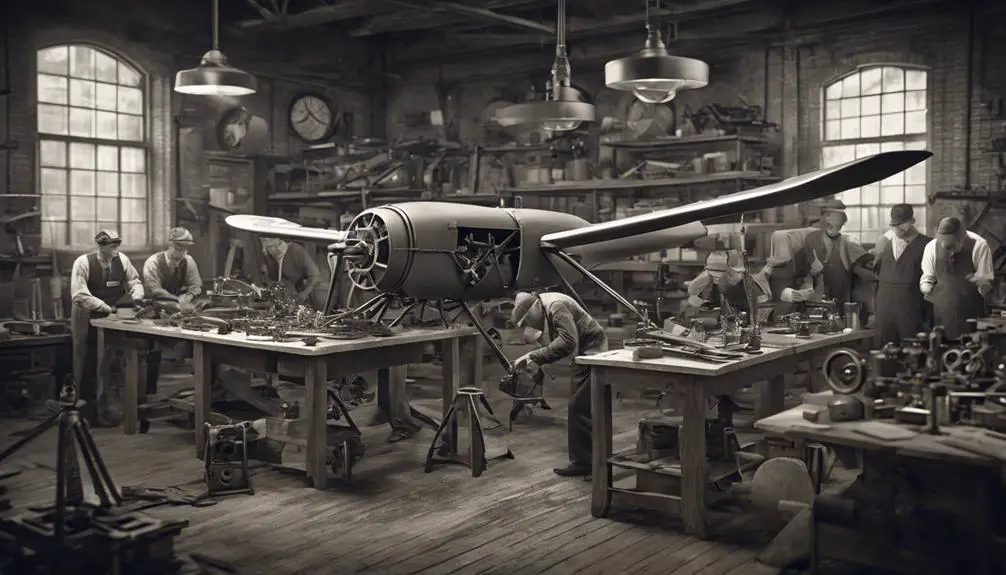Drones were invented in the early 20th century, specifically evolving after World War I. These remote-controlled flying machines were initially used for military purposes, providing reconnaissance capabilities that kept soldiers safe in battle. Over time, drone technology transformed considerably, especially with advancements like GPS in the 1990s. They became more accessible for various civilian applications, from agriculture to creative industries. Today's drones are versatile tools that aid in many fields, showcasing just how far they've come. If you're curious about their journey and current uses, there's plenty more to explore.
Early Concepts of Aerial Vehicles
From ancient imagination to early innovations, the concept of aerial vehicles has fascinated humanity for centuries. You can feel the thrill as you envision those first dreamers, sketching wings made of feathers and wood, yearning to soar above the constraints of the earth. Think of the inventors who dared to challenge gravity, creating kites and gliders, driven by a desire for freedom that resonates through time. These pioneers believed in the limitless possibilities of the skies, igniting a spirit of exploration that still lives in us today. The quest for flight wasn't just about reaching new heights; it was about breaking free from earthly bounds. You, too, can embrace that spirit, exploring the sky's vast expanse as others once dreamed of doing.
Military Innovations in World War I
World War I sparked a wave of military innovations, transforming how battles were fought and laying the groundwork for modern warfare. You'd witness the introduction of tanks, which broke through trench lines, and airplanes, which shifted warfare into the skies. The machine gun changed the dynamics of firepower, making traditional charges obsolete. Chemical weapons, while controversial, represented a new level of destruction, highlighting the lengths nations would go to achieve victory. These advancements weren't just about technology; they reflected a struggle for freedom and survival. Soldiers found new ways to adapt, pushing the boundaries of strategy and resilience. The lessons learned during this tumultuous time paved the way for future conflicts, emphasizing the persistent human desire for liberty amidst chaos.
Development of Remote-Controlled Drones
The innovations in military technology during World War I set the stage for the development of remote-controlled drones, which would revolutionize aerial warfare in the decades to come. As the technology evolved, you'd witness remarkable advancements that aligned with the spirit of freedom and exploration. Remote-controlled drones emerged, providing new opportunities for various applications, including:
- Enhanced reconnaissance capabilities
- Safer operations in dangerous environments
These drones allowed you to push boundaries, whether in military operations or personal exploration. You could navigate the skies without risking lives, marking a significant shift in how humans interacted with technology. The journey of remote-controlled drones was just beginning, but their potential was already limitless.
Evolution Through the Decades
As technology progressed, drones evolved considerably through the decades, adapting to new demands and capabilities. You've seen the shift from rudimentary remote-controlled models to sophisticated machines equipped with advanced sensors and automation. Each decade brought breakthroughs that expanded their potential—like the introduction of GPS in the 1990s, which transformed navigation and precision. By the 2000s, drones began to serve various sectors, proving their versatility. You might appreciate how innovations in battery life and materials allowed for longer flights and increased stability. With each leap forward, drones became more accessible, empowering individuals and small businesses to harness their potential. This evolution reflects a spirit of innovation and freedom, allowing you to explore new horizons and redefine what's possible.
Drones in Modern Applications
Drones have become essential tools across various industries, revolutionizing how tasks are accomplished and making processes more efficient. You'll find them enhancing creativity and freedom in ways you might not expect. Here's how they're changing the game:
- Delivery Services: Companies are using drones to bring packages directly to your doorstep, cutting down on delivery times.
- Agricultural Monitoring: Farmers employ drones for crop surveillance, ensuring better yields and sustainable practices.
These advancements let you experience a world where technology amplifies your ability to connect, explore, and innovate without limitations. Embrace the future and the freedom that drones bring to everyday life!

